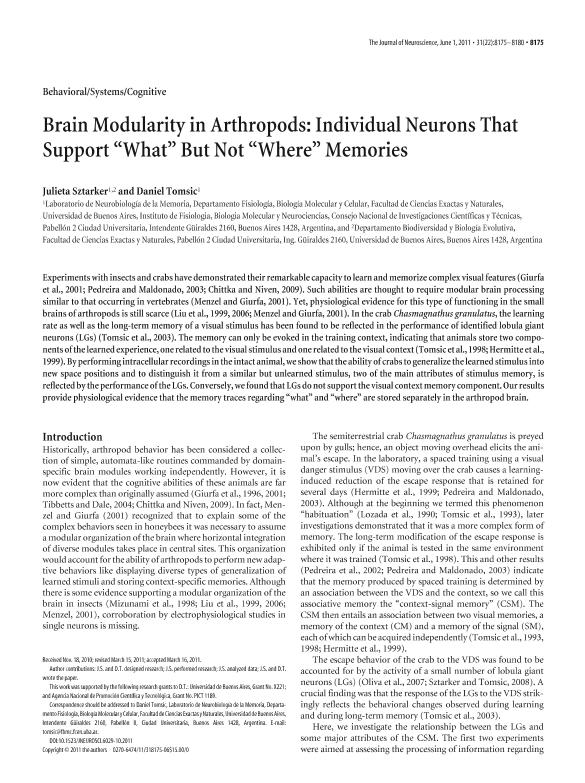Artículo
Brain modularity in arthropods: individual neurons that support “what” but not “where” memories
Fecha de publicación:
06/2011
Editorial:
Society for Neuroscience
Revista:
Journal of Neuroscience
ISSN:
0270-6474
e-ISSN:
1529-2401
Idioma:
Inglés
Tipo de recurso:
Artículo publicado
Clasificación temática:
Resumen
Experiments with insects and crabs have demonstrated their remarkable capacity to learn and memorize complex visual features (Giurfa et al., 2001; Pedreira and Maldonado, 2003; Chittka and Niven, 2009). Such abilities are thought to require modular brain processing similar to that occurring in vertebrates (Menzel and Giurfa, 2001). Yet, physiological evidence for this type of functioning in the small brains of arthropods is still scarce (Liu et al., 1999, 2006; Menzel and Giurfa, 2001). In the crab Chasmagnathus granulatus, the learning rate as well as the long-term memory of a visual stimulus has been found to be reflected in the performance of identified lobula giant neurons (LGs) (Tomsic et al., 2003). The memory can only be evoked in the training context, indicating that animals store two components ofthe learned experience, one relatedtothe visual stimulus and one relatedtothe visual context (Tomsic et al., 1998; Hermitte et al., 1999). By performing intracellular recordings inthe intact animal, we showthatthe ability of crabsto generalizethe learned stimulus into new space positions and to distinguish it from a similar but unlearned stimulus, two of the main attributes of stimulus memory, is reflected bythe performance ofthe LGs. Conversely, wefoundthat LGs do not supportthe visual context memory component. Our results provide physiological evidence that the memory traces regarding “what” and “where” are stored separately in the arthropod brain.
Palabras clave:
Learning
,
Generalization
,
Escape Response
,
Intracellular Recordings
Archivos asociados
Licencia
Identificadores
Colecciones
Articulos(IFIBYNE)
Articulos de INST.DE FISIOL., BIOL.MOLECULAR Y NEUROCIENCIAS
Articulos de INST.DE FISIOL., BIOL.MOLECULAR Y NEUROCIENCIAS
Citación
Sztarker, Julieta; Tomsic, Daniel; Brain modularity in arthropods: individual neurons that support “what” but not “where” memories; Society for Neuroscience; Journal of Neuroscience; 31; 22; 6-2011; 8175-8180
Compartir
Altmétricas




